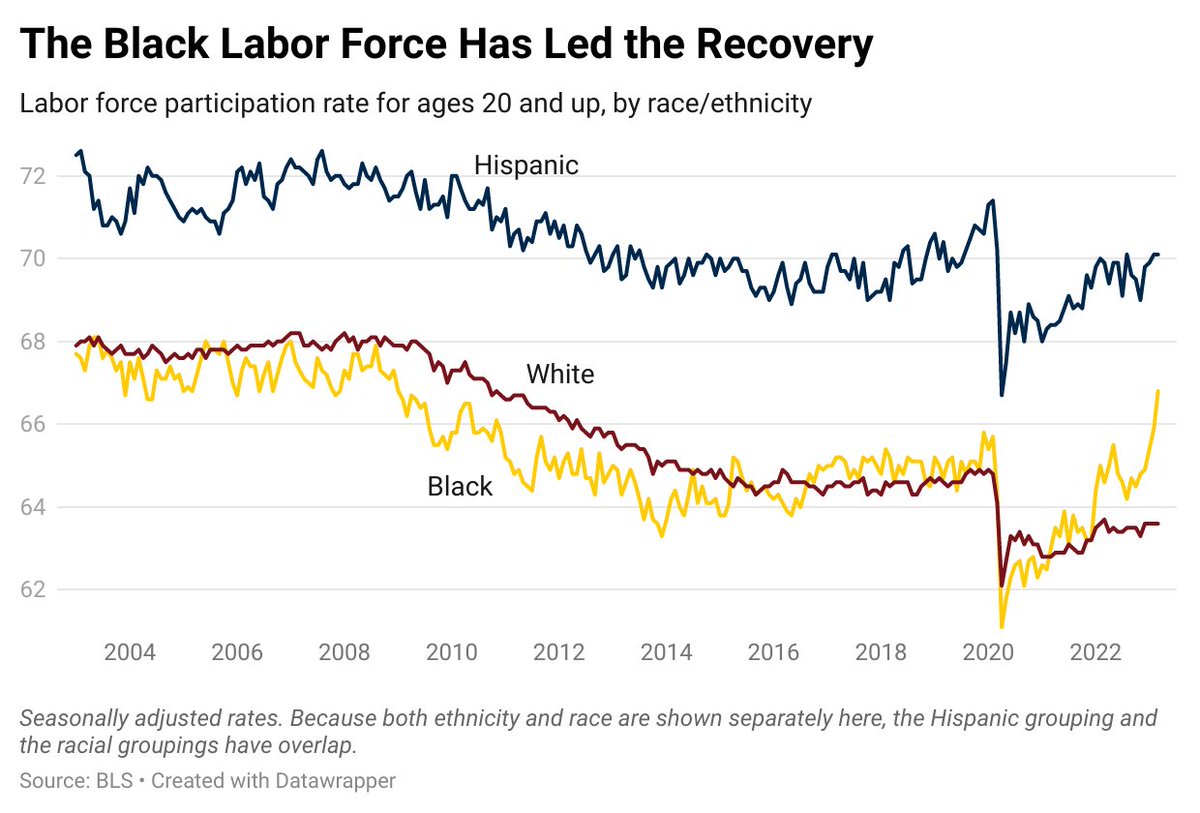Employment Report: Examining Inequality in Unemployment
We can have historically low unemployment rates when we reduce inequality in unemployment. This thread dives deeper into the employment report and explores how labor market improvements for African Americans are not just about the record low unemployment rate.

Betsey Stevenson
Former Member of President Obama’s Council of Economic Advisers & Chief Economist at Labor. Current academic economist at Michigan. Always an economist at home.

-
Time for a deeper dive into the employment report. Follow the thread or read more here:https://t.co/7q9LUJKICj#UMPovertySolutions @FordSchool #JobsReport
— Betsey Stevenson (@BetseyStevenson) April 7, 2023 -
When people are calling for the unemployment rate to go up to fight inflation, whose unemployment do they mean?
— Betsey Stevenson (@BetseyStevenson) April 7, 2023 -
Isn't an unemployment rate that is just as low for Black and Hispanic workers as for white workers consistent with stable prices? We can have historically low unemployment rates when we reduce inequality in unemployment.
— Betsey Stevenson (@BetseyStevenson) April 7, 2023 -
Labor market improvements for African Americans are not just about the record low unemployment rate. Black people now have much higher rates of labor force participation than white people. pic.twitter.com/BWzYA9SgiS
— Betsey Stevenson (@BetseyStevenson) April 7, 2023 -
Turning to cities: rural areas are really struggling to get people back to work. Labor force participation rates in the largest cities are above pre-pandemic levels & a new gap has emerged between big & smaller cities. pic.twitter.com/ugN76w3sGi
— Betsey Stevenson (@BetseyStevenson) April 7, 2023 -
Rural areas are also struggling more with aging, so the labor force participation rate has completely stagnated in rural areas for all adults. pic.twitter.com/Kdy2QLOR9M
— Betsey Stevenson (@BetseyStevenson) April 7, 2023 -
At the worst part of the pandemic, a large gap had emerged with fewer available foreign-born workers. In the middle of 2021, a large gap in the number of foreign-born workers remained, but it began to rapidly close pic.twitter.com/3QXRGZWLeD
— Betsey Stevenson (@BetseyStevenson) April 7, 2023 -
Growth in foreign-born male workers continued over the past year, and has returned to a pre-pandemic trend line. pic.twitter.com/xOhTexdmYU
— Betsey Stevenson (@BetseyStevenson) April 7, 2023 -
The same is not true for foreign-born women. The question will be whether these women return to fill the continued growth in service sector jobs. pic.twitter.com/fII9l2HzW5
— Betsey Stevenson (@BetseyStevenson) April 7, 2023 -
One big question has been labor force participation: It’s not recovering for older people, it has recovered among prime age people. Parsing prime age people further, women, particularly those ages 35 to 44 have had the strongest growth in labor force participation. pic.twitter.com/CCO3JOJWSv
— Betsey Stevenson (@BetseyStevenson) April 7, 2023 -
The public sector has been slow to recover from the pandemic. Employment remains at 98.6% of February 2020 levels, despite the addition of 47,000 jobs in March 2023. Over the past 3 months, growth has occurred at all levels of government adding 226,000 govt jobs. pic.twitter.com/uVglbxczQz
— Betsey Stevenson (@BetseyStevenson) April 7, 2023 -
The goods sector is stagnating in job creation and the service-sector is pulling away. The gap between them will continue to grow over the next year, matching historic patterns of an expanding service sector relative to goods-producing sector. pic.twitter.com/gBwJNMo8ta
— Betsey Stevenson (@BetseyStevenson) April 7, 2023
